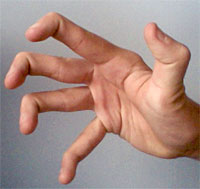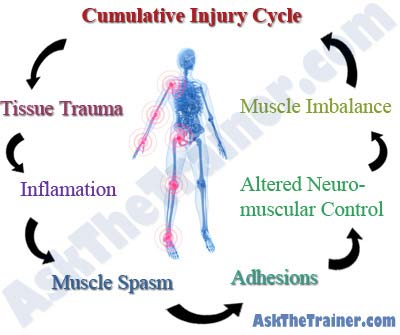- Like
- SHARE
- Digg
- Del
- Tumblr
- VKontakte
- Flattr
- Buffer
- Love This
- Save
- Odnoklassniki
- Meneame
- Blogger
- Amazon
- Yahoo Mail
- Gmail
- AOL
- Newsvine
- HackerNews
- Evernote
- MySpace
- Mail.ru
- Viadeo
- Line
- Comments
- Yummly
- SMS
- Viber
- Telegram
- JOIN
- Skype
- Facebook Messenger
- Kakao
- LiveJournal
- Yammer
- Edgar
- Fintel
- Mix
- Instapaper
- Copy Link
 Tips to Avoid Five Common Workout-related Injuries
Tips to Avoid Five Common Workout-related Injuries
Every year, hundreds of thousands of people suffer from workout-related injuries. It doesn’t matter if you’re a seasoned pro or a fitness novice, you could still hurt yourself if you’re not careful.
In order to avoid being sidelined, make sure you’re following these tips to avoid five of the most common weight training injuries.
#1. Ankle Sprain
 Ankle sprains aren’t just for outdoor runners. If you spend a lot of time jogging or running on the treadmill, you could find yourself dealing with this pesky injury if you’re not careful.
Ankle sprains aren’t just for outdoor runners. If you spend a lot of time jogging or running on the treadmill, you could find yourself dealing with this pesky injury if you’re not careful.
In fact, you may be susceptible to ankle sprains if running on the treadmill is the norm for you. This is because most people tend to zone out while on the treadmill and end up accidentally stepping off the belt while it’s
still in motion. You could also sprain your ankle if you jump off too quickly.
To avoid treadmill-related ankle injuries, be sure to take advantage of the clip that you can attach to your clothes. This clip will stop the machine if you happen to trip or fall.
You should also avoid increasing the speed too quickly and never jump off while the belt is still moving. Let it come to a complete stop before you try to get off.
#2. Low Back Strain
Exercise is often prescribed to treat low back pain, but it can also cause pain if you’re not watching your form.
Common weight training exercises like squats and deadlifts can wreak havoc on your low back if your form is incorrect. Strains are highly common, but you can also deal with nerve compression and disc herniation if you continue to practice bad form.
To avoid low back injury or pain while squatting or deadlifting, make sure you keep your spine neutral. This means you’re not hunching or over-arching your back.
If you’re not sure what a neutral spine feels like, lie on the floor with your knees bent and your feet flat. There should be a slight curve in your spine, but your neck and low back should stay on the floor.
You should also avoid lifting too much weight right away. Start by using just the bar if you have to to get your form down.
Don’t worry about how much the person next to you is squatting or pulling — it’s better to lift a lightweight with perfect form than to lift heavy with bad form.
#3. Rotator Cuff Strain or Tear
 The rotator cuff is comprised of four muscles that keep your shoulder joint stable. These muscles are the subscapularis, teres minor, supraspinatus, and infraspinatus.
The rotator cuff is comprised of four muscles that keep your shoulder joint stable. These muscles are the subscapularis, teres minor, supraspinatus, and infraspinatus.
If you notice pain in your shoulder when you reach out to the side, overhead, or behind you, you may be dealing with a rotator cuff strain or tear.
The most common culprit of this injury is repeated overhead activity. If you’re frequently swimming or doing exercises like military presses, it’s easy to put too much pressure on your rotator cuff.
You don’t have to give up these exercises altogether. But, you should warm up properly before training your upper body and work on strengthening the muscles around the rotator cuff. Exercises like high and low cable rows, the reverse fly, and the doorway stretch can help.
As with squatting and deadlifting, you should also avoid using too much weight when doing military presses and other overhead exercises, as this will increase the strain on your rotator cuff.
#4. Hand and Wrist Pain
 When they first start lifting weights, many people deal with pain in their hand and wrist.
When they first start lifting weights, many people deal with pain in their hand and wrist.
To avoid this pain, avoid lifting too much weight, especially during exercises like bicep curls and bench presses.
Some of your pain may come from lack of development of the muscles in the hands and wrists.
To strengthen these muscles, do exercises like wrist curls with light weights. Therapy putty, which is often used in hand injury therapy, is also a good tool to build muscle in the hands, wrists, and forearms and improve your grip and forearm strength.
You can also use wrist straps to take pressure off the wrists and help you with heavier lifts. But, you shouldn’t rely solely on these straps. Make sure you’re also putting in the effort to strengthen the wrists and hands on your own.
#5. Patellofemoral Pain Syndrome
 Patellofemoral pain syndrome (runner’s knee) is characterized by pain under the kneecap. This pain usually gets worse when you run, walk down the stairs, or sit with your knees bent for a long time.
Patellofemoral pain syndrome (runner’s knee) is characterized by pain under the kneecap. This pain usually gets worse when you run, walk down the stairs, or sit with your knees bent for a long time.
Even if you’re not a runner, you can still suffer from patellofemoral syndrome. It’s also caused by jumping and squatting. It occurs when the bones in the lower leg are not properly lined up. This leads to a misalignment of the femur and kneecap. Over time, the misalignment causes cartilage damage and pain.
To avoid patellofemoral syndrome, be sure to practice proper form while running, squatting, and jumping. You should also take time to strengthen the quadriceps and hip flexors by doing exercises like lying and seated leg raises.
Many common gym injuries, including the five listed above, can be avoided simply by practicing proper form and avoiding the urge to do more than you’re safely capable of.
The Bottom Line
Keep these tips in mind during your next gym session, and you’ll avoid having to take time off to deal with an annoying — and painful — injury.



